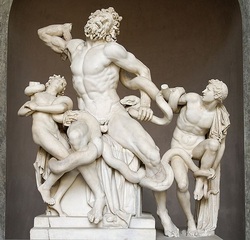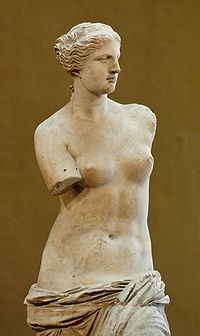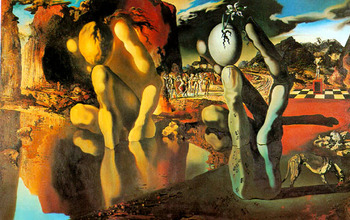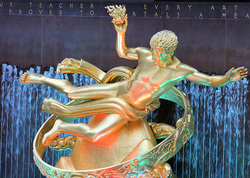Lacoon and His Sons

Hagesandros, Athenedoros, and Polydoros, Early First Century BC
Statue of White Marble
Vatican Museum, Rome
The statue of Laocoön and His Sons (Italian: Gruppo del Laocoonte), also called the Laocoön Group, is a monumental sculpture in marble now in the Vatican Museums, Rome. The statue is attributed by the Roman author Pliny the Elder to three sculptors from the island of Rhodes: Agesander, Athenodoros and Polydorus. It shows the Trojan priest Laocoön and his sons Antiphantes and Thymbraeus being strangled by sea serpents. (wiki)
Statue of White Marble
Vatican Museum, Rome
The statue of Laocoön and His Sons (Italian: Gruppo del Laocoonte), also called the Laocoön Group, is a monumental sculpture in marble now in the Vatican Museums, Rome. The statue is attributed by the Roman author Pliny the Elder to three sculptors from the island of Rhodes: Agesander, Athenodoros and Polydorus. It shows the Trojan priest Laocoön and his sons Antiphantes and Thymbraeus being strangled by sea serpents. (wiki)
Venus de Milo

Alexandros of Antioch, 130-100 BC
Marble
Louvre Museum, Paris
Aphrodite of Milos (Greek: Ἀφροδίτη τῆς Μήλου, Aphroditē tēs Mēlou), better known as the Venus de Milo, is an ancient Greek statue and one of the most famous works of ancient Greek sculpture. Created at some time between 130 and 100 BCE, it is believed to depict Aphrodite (Venus to the Romans) the Greek goddess of love and beauty. It is a marble sculpture, slightly larger than life size at 203 cm (6 ft 8 in) high. Its arms and original plinth have been lost. From an inscription that was on its plinth, it is thought to be the work of Alexandros of Antioch; it was earlier mistakenly attributed to the master sculptor Praxiteles. It is at present on display at the Louvre Museum in Paris. (wiki)
Marble
Louvre Museum, Paris
Aphrodite of Milos (Greek: Ἀφροδίτη τῆς Μήλου, Aphroditē tēs Mēlou), better known as the Venus de Milo, is an ancient Greek statue and one of the most famous works of ancient Greek sculpture. Created at some time between 130 and 100 BCE, it is believed to depict Aphrodite (Venus to the Romans) the Greek goddess of love and beauty. It is a marble sculpture, slightly larger than life size at 203 cm (6 ft 8 in) high. Its arms and original plinth have been lost. From an inscription that was on its plinth, it is thought to be the work of Alexandros of Antioch; it was earlier mistakenly attributed to the master sculptor Praxiteles. It is at present on display at the Louvre Museum in Paris. (wiki)
The Metamorphosis of Narcissus

Salvador Dali, 1937
An oil on canvas painting
The painting shows Narcissus sitting in a pool, gazing down. Not far away there is a decaying stone figure which corresponds closely to him but is perceived quite differently; as a hand holding up a bulb or egg from which a Narcissus is growing. The egg has been used as a symbol for sexuality in other paintings by Dali. In the background, a group of naked figures can be seen, while a third Narcissus like figure appears on the horizon. (wiki)
An oil on canvas painting
The painting shows Narcissus sitting in a pool, gazing down. Not far away there is a decaying stone figure which corresponds closely to him but is perceived quite differently; as a hand holding up a bulb or egg from which a Narcissus is growing. The egg has been used as a symbol for sexuality in other paintings by Dali. In the background, a group of naked figures can be seen, while a third Narcissus like figure appears on the horizon. (wiki)
Statue of Prometheus at Rockefeller Center

Paul Manship's highly recognizable bronze gilded statue of the Greek legend of the Titan Prometheus recumbent, bringing fire to mankind, features prominently in the sunken plaza at the front of 30 Rockefeller Plaza. The model for Prometheus was Leonardo (Leon) Nole, and the inscription from Aeschylus, on the granite wall behind, reads: "Prometheus, teacher in every art, brought the fire that hath proved to mortals a means to mighty ends." Although some sources cite it as the fourth-most familiar statue in the United States, behind the Lincoln Memorial, Mount Rushmore and the Statue of Liberty, Manship was not particularly fond or proud of it. (wiki)
